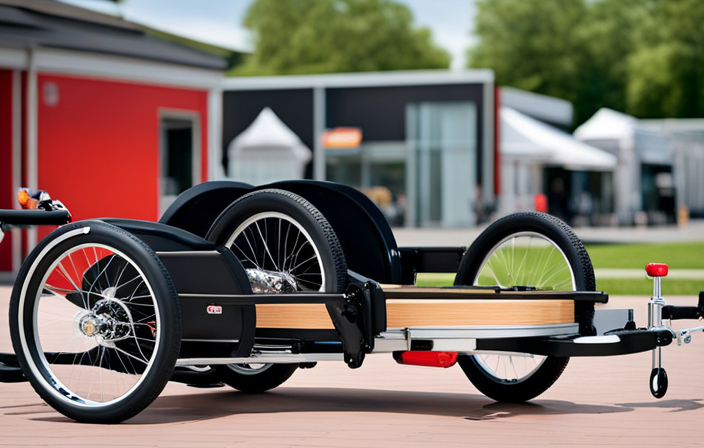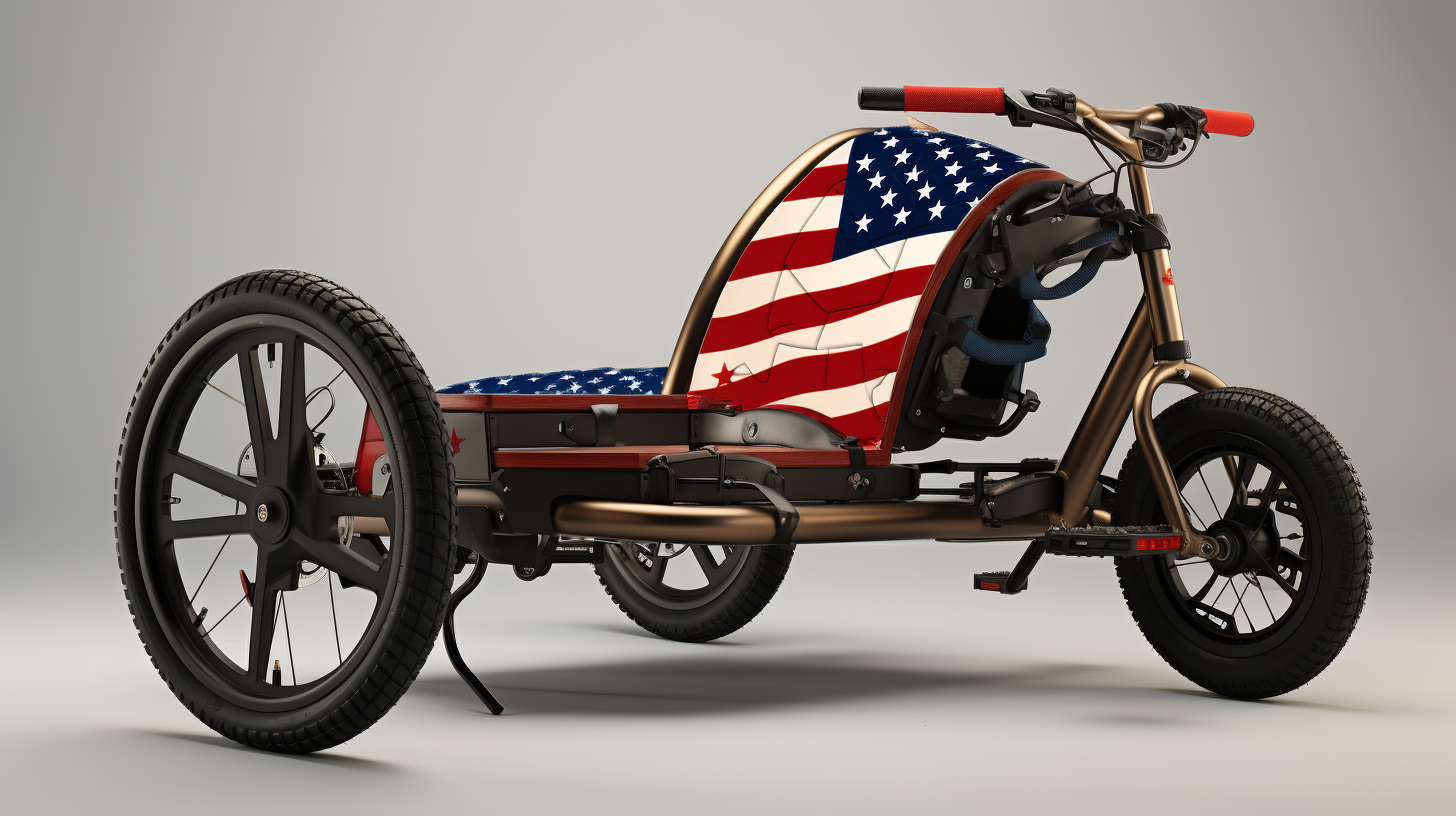Cargo bikes are changing the game in urban logistics, making hauling goods faster and simpler. With their impressive load capacities and ability to navigate city streets, you can enjoy quicker deliveries without the hassle of traffic. Not only do they reduce congestion and emissions, but they also save costs on operations. As cities invest in infrastructure and innovative projects, the future of cargo bikes looks promising. Discover how these bikes can transform urban living even more.
Key Takeaways
- Cargo bikes are revolutionizing last-mile delivery by providing a faster, more efficient alternative to traditional delivery vans.
- Their versatile load capacity ranges from 40 to 250 kg, making them ideal for various hauling needs.
- The eco-friendly design of cargo bikes emits only 10% of the carbon emissions of cars, promoting sustainable urban transport.
- Cities are investing in infrastructure like bike lanes and charging stations to support the growing use of cargo bikes.
- Subscription models make cargo bikes accessible, allowing users to test the technology with lower financial commitment for occasional or daily use.
Urban Delivery Challenges and Trends
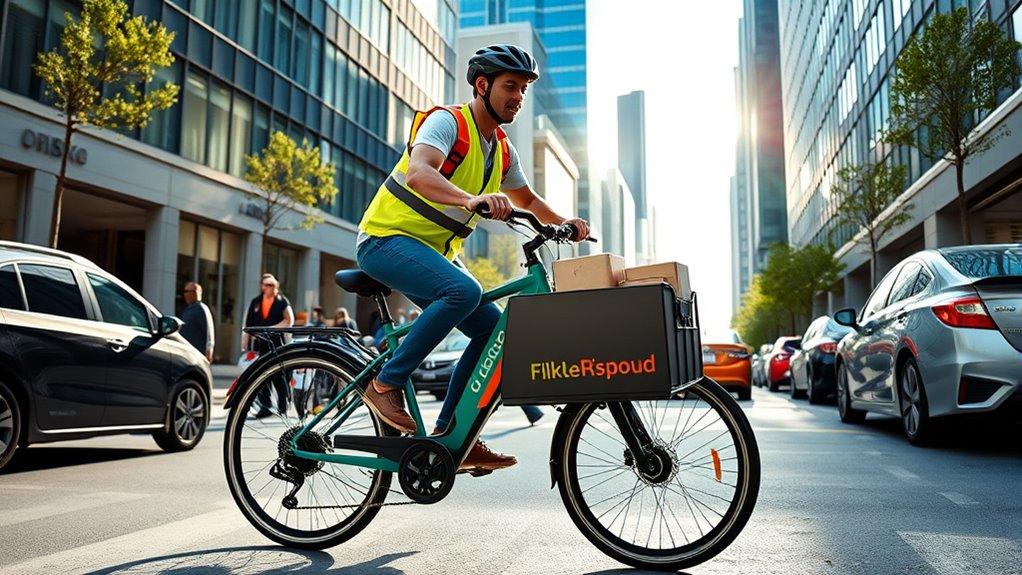
As e-commerce grows rapidly, urban areas face mounting pressure on their last-mile delivery systems, and you might’ve noticed the innovative solutions popping up to tackle these challenges.
One standout solution is the cargo bike, designed specifically for short-distance load transport. These bikes can carry between 40 to 250 kilograms, making them ideal for urban delivery challenges.
Cities like Berlin have established permanent bike lanes during the pandemic, enhancing the logistics of last-mile delivery. Additionally, Germany and Austria have introduced subsidies and bike-sharing networks to boost cargo bike adoption. Furthermore, the rise of portable power solutions has made it easier for delivery services to stay connected and efficient on the go.
Benefits of Cargo Bikes: Speed and Efficiency

Urban areas are increasingly turning to cargo bikes as a solution to last-mile delivery challenges, thanks to their speed and efficiency.
Cargo bikes make parcel deliveries 60% faster than traditional delivery vans, making them a game-changer for urban logistics. With a load capacity of 40 to 250 kilograms, they provide a versatile solution for transporting goods.
The electric assist options enhance efficiency, allowing you to deliver quicker without excessive physical strain. Additionally, using cargo bikes reduces car trips by 41%, which helps improve traffic flow and cut down on congestion.
They’re also more cost-effective than cars, leading to lower operational costs for businesses. Embracing cargo bikes can considerably increase the efficiency of your delivery operations. Furthermore, their use contributes to asset diversification by reducing dependency on traditional delivery methods and promoting sustainable practices.
Sustainable Solutions for Last-Mile Logistics
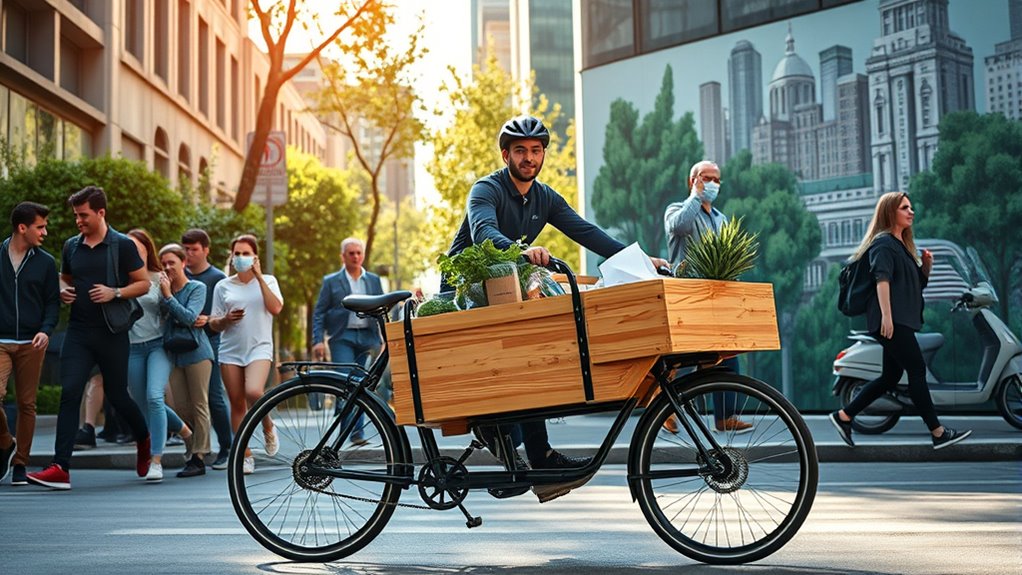
While many solutions exist for last-mile logistics, few match the sustainability and efficiency of cargo bikes. These human-powered vehicles deliver parcels 60% faster than traditional vans, drastically improving user experience while slashing carbon emissions.
With cargo bikes emitting only 10% of the emissions produced by cars, they present a compelling case for private use in urban areas. As e-commerce continues to rise, these sustainable solutions not only help reduce traffic congestion but also enhance urban air quality.
Companies that adopt cargo bikes enjoy lower delivery costs and align with consumer demand for eco-friendly options, giving them a competitive edge in the market. Embracing cargo bikes is a smart move for sustainable logistics. Additionally, just as tiny home living promotes a minimalist lifestyle, cargo bikes encourage a simpler, more efficient approach to urban transport.
Infrastructure Development for Cargo Bikes
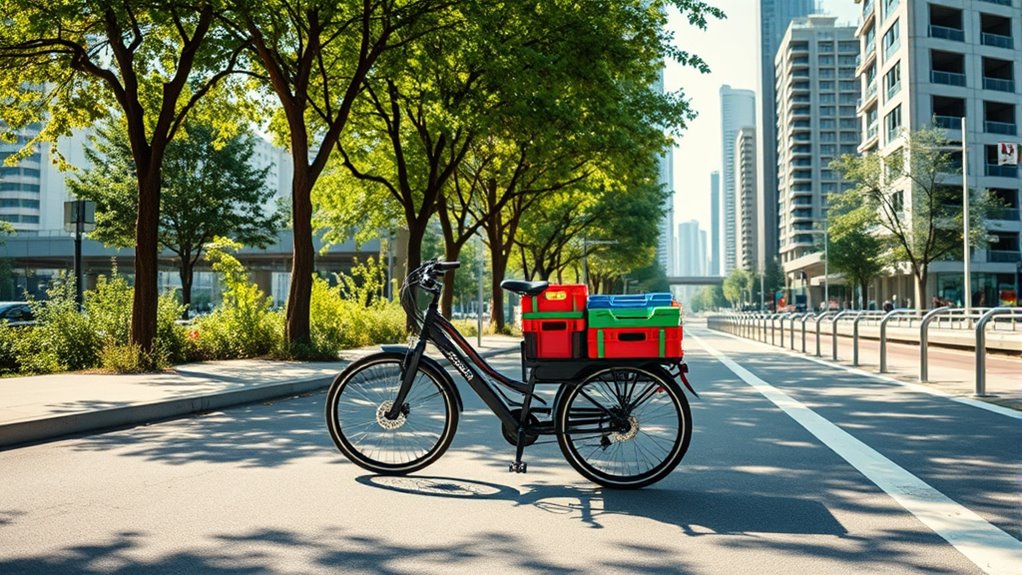
To effectively support cargo bikes in urban areas, you’ll need to focus on essential planning and infrastructure development. Cities that integrate digital tools for route planning will see improved delivery efficiency and operational effectiveness. Furthermore, the adoption of green transportation options can significantly reduce urban congestion and pollution levels.
Essential Planning Considerations
How can cities effectively integrate cargo bikes into their transportation networks? To guarantee success, cities must prioritize robust planning and dedicated infrastructure. Establishing bike lanes and designated bike storage areas is essential, especially for the largest fleet of cargo bikes. Additionally, supportive policies that encourage micro-mobility can help reduce reliance on cars in the city. Incorporating strong brand identity in cargo bike initiatives can also enhance community engagement and support for sustainable transport solutions.
| Infrastructure Needs | Benefits |
|---|---|
| Designated bike lanes | Safe and efficient routes |
| Cargo bike storage | Increased operational capacity |
| Supportive city policies | Enhanced urban livability |
Digital Tools Integration
As cities embrace the rise of cargo bikes, integrating digital tools becomes essential for maximizing their potential. These bikes need dedicated infrastructure, like bike lanes and charging stations, to thrive.
Digital tools, such as route planning software, help you optimize delivery routes in real-time, enhancing efficiency. Projects like SmartRadL specifically target the unique demands of cargo bike transport, addressing data gaps for better route planning.
With effective tool integration, you can boost customer satisfaction through real-time delivery tracking and improved communication with recipients. As investments in eco-friendly logistics grow, think I’m not alone in seeing how vital digital solutions are for reducing car dependency and supporting sustainable urban transport. Furthermore, the integration of AI tools can enhance real-time performance tracking, ensuring a smoother operation for cargo bike logistics.
Let’s make cargo bikes a viable option for all!
Innovative Projects Shaping the Future
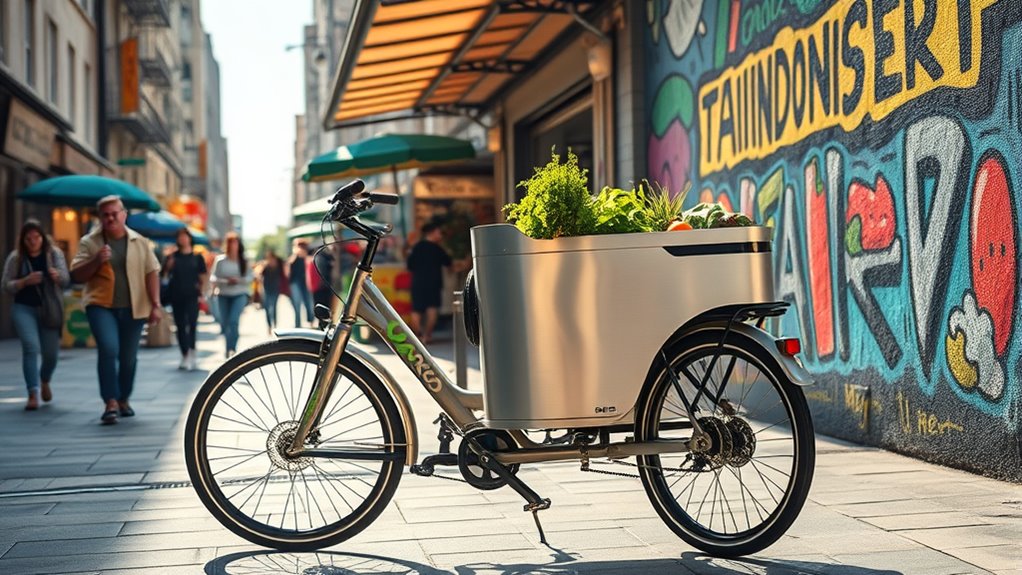
As you explore the future of cargo bikes, you’ll find exciting projects like the SmartRadL initiative, which optimizes delivery routes with innovative software.
The Cargobike Index is also enhancing safety by evaluating road suitability for riders.
Plus, the Cargorocket startup shows how creativity in logistics can transform last-mile delivery. Furthermore, incorporating predictive analytics into cargo bike logistics can optimize route planning and reduce delivery times.
SmartRadL Project Insights
While urban logistics face growing challenges, the SmartRadL project is paving the way for more efficient cargo bike deliveries. By developing innovative software solutions, it tailors route planning specifically for cargo bike transport, addressing vital data gaps that often hinder bike-friendly routes.
Emerging from a hackathon organized by Baden-Württemberg’s Ministry of Transport, SmartRadL highlights the power of collaboration in improving cargo bike logistics. The project places a strong emphasis on real-time monitoring and tracking of deliveries, enhancing operational responsiveness and boosting customer satisfaction.
Additionally, ongoing discussions about necessary standards and data for effective routing are essential for the successful implementation of cargo bikes in last-mile logistics, ensuring they become a reliable choice for urban deliveries. Furthermore, the integration of supernatural lore into urban narratives can inspire creative marketing strategies that resonate with community values.
Cargorocket Startup Innovations
Building on the momentum created by initiatives like the SmartRadL project, Cargorocket is revolutionizing cargo bike logistics with its innovative software solutions.
Emerging from a hackathon organized by Baden-Württemberg’s Ministry of Transport, Cargorocket focuses on enhancing logistics for last-mile deliveries in urban areas. Their platform targets the growing demand for efficiency, allowing real-time monitoring and tracking of cargo bike operations.
By contributing to the Cargobike Index, Cargorocket helps assess road suitability for cargo transport, promoting safer routes. The startup emphasizes the importance of standardized data and routing guidelines, ensuring seamless integration of cargo bikes into urban transport systems.
With these innovations, Cargorocket is shaping a more efficient future for urban logistics, particularly as emergency preparedness essentials become increasingly vital in urban planning to address unforeseen disruptions.
Cargobike Index Developments
The Cargobike Index is transforming urban logistics by evaluating and publishing essential data on road suitability for cargo bike usage across Germany.
By leveraging real-time data, it identifies ideal routes, enhancing delivery efficiency while promoting sustainable urban mobility.
You’re part of a growing movement that recognizes cargo bikes as a solution for last-mile delivery challenges in bustling cities.
As discussions continue, establishing necessary standards and data requirements will further enhance routing for cargo bikes, directly impacting infrastructure improvements.
This initiative not only addresses existing data gaps but also influences future transport policies, making cities more bike-friendly.
With the Cargobike Index, you’re contributing to a greener and more efficient urban landscape. Additionally, the integration of advanced filtration systems in urban infrastructure could further improve air quality in city environments.
Market Growth and Design Evolution

As cargo bike sales surge across Europe, it’s clear that this mode of transportation is gaining traction among families and urban commuters alike. Germany’s impressive 212,000 sales last year, alongside Belgium’s eight-fold increase, showcases a booming market. France’s staggering 96% growth, fueled by over 40 local manufacturers, further emphasizes this trend.
Designers are working up to five years ahead to innovate and improve safety, driven by user feedback that shapes their creations. Here’s a snapshot of the market growth:
| Country | Sales Growth | Notable Features |
|---|---|---|
| Germany | 212,000 bikes | High demand |
| Belgium | 8-fold increase | Rapid adoption |
| France | 96% year-on-year | Local manufacturers |
This evolution signals a bright future for cargo bikes.
User Experience and Adoption Strategies
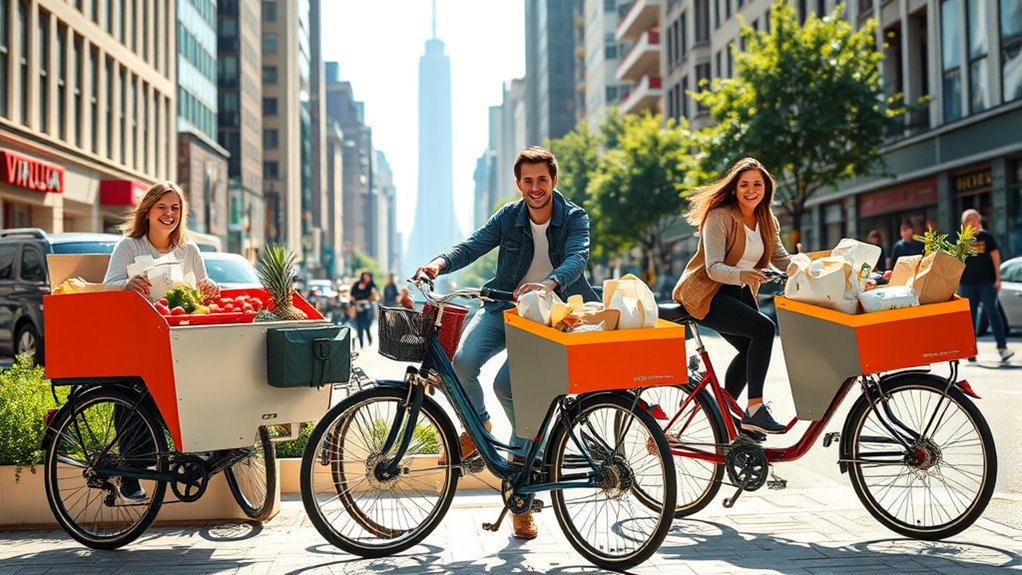
Many new users find the initial experience of riding a cargo bike intimidating, which is why test rides and familiarization are essential for boosting comfort and long-term adoption.
The design and appeal of cargo bikes play a significant role in your acceptance; you’ll appreciate options that balance aesthetics with functionality for urban needs.
While changing, you might face emotional and physical challenges, but a positive first ride can lead to increased confidence and satisfaction.
Successful adoption strategies focus on making you feel at ease with the technology, encouraging you to use cargo bikes more often.
Subscription Models for Accessibility
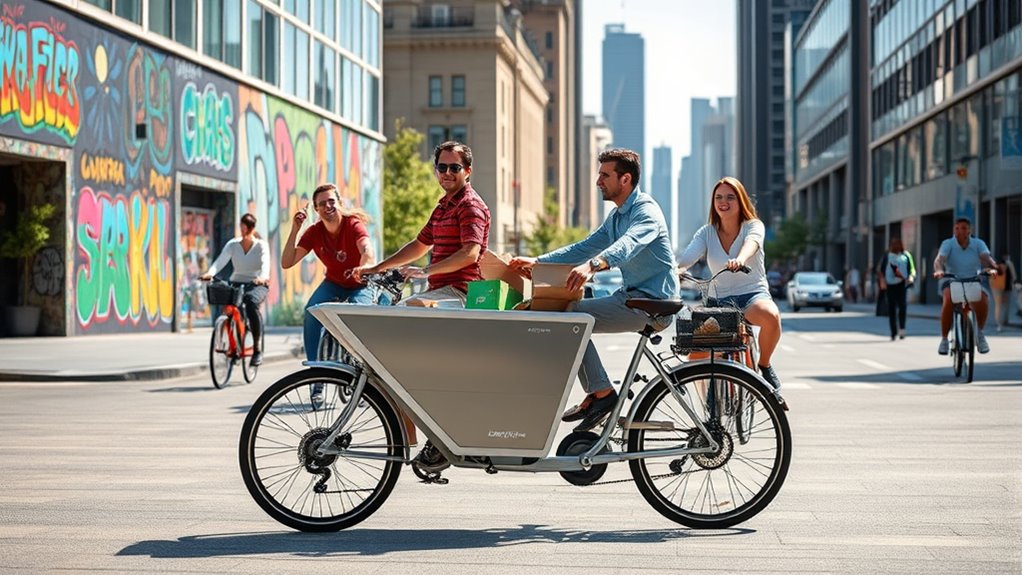
While considering a cargo bike, you might find subscription models an appealing option that lowers financial barriers and makes biking more accessible.
These models allow you to choose plans tailored to your needs, whether you need a bike for occasional trips or daily errands. The flexibility they provide means you can test out cargo biking without the commitment of an outright purchase.
If you’re new to cycling, subscription services simplify the experience, giving you a hassle-free way to shift into cargo biking. This approach encourages families to return to cycling, with lower upfront costs making it easier to explore this eco-friendly transport option.
Business Challenges and Future Outlook

Maneuvering the cargo bike market presents several business challenges that demand innovative solutions for long-term success. Financial restructuring is essential; without adaptive business models, companies can struggle to thrive in this competitive landscape.
You might face stakeholder disagreements that can stall progress and hinder innovation. In response, mergers and acquisitions could become necessary as businesses seek to consolidate resources and strengthen their market positions amid financial pressures.
Despite these hurdles, the future outlook for cargo bikes remains bright. Increasing demand for sustainable urban transport solutions and potential government support can drive growth.
With billions in investments anticipated to facilitate shifts in transportation habits, you can be optimistic about the evolving cargo bike industry.
The Impact of Cargo Bikes on Urban Living

Cargo bikes are transforming urban living by enhancing mobility and reducing congestion.
When you choose a cargo bike, you’re not just getting around faster; you’re also contributing to cleaner air and a more sustainable city.
As cities adapt their infrastructure to support these bikes, you’ll see a significant shift in how people move and deliver goods.
Enhanced Urban Mobility
As urban areas become more congested, cargo bikes emerge as a practical solution for enhancing mobility and reducing reliance on cars. These versatile bikes can carry between 40 to 250 kilograms, making them ideal for transporting goods without the hassle of traditional vehicles.
In cities like Berlin, dedicated bike lanes have boosted cargo bike use for last-mile delivery, streamlining logistics and improving accessibility. You’ll find that cargo bikes deliver parcels 60% faster than traditional vans, which helps ease traffic congestion.
Furthermore, studies show that owning a cargo bike can reduce car trips by 41%, promoting road safety. With growing consumer demand for eco-friendly delivery options, businesses adopting cargo bikes benefit from lower operational costs and improved urban livability.
Environmental Benefits
While urban living often comes with challenges like traffic and pollution, cargo bikes present a sustainable alternative that benefits both the environment and city dwellers.
By opting for cargo bikes, you can enjoy several significant environmental advantages:
- Lower Emissions: Cargo bikes emit only 10% of the carbon emissions produced by cars, making them a much greener choice for deliveries.
- Reduced Traffic Congestion: Using cargo bikes helps alleviate road congestion, leading to safer streets and a more livable urban environment.
- Improved Air Quality: Owners report a 41% reduction in car trips, which contributes to better air quality in cities.
As consumers increasingly favor eco-friendly delivery options, cargo bikes not only enhance efficiency but also support a more sustainable urban lifestyle.
Frequently Asked Questions
What Is the History of Cargo Bikes?
Cargo bikes have an interesting history that dates back to the 19th century.
You’ll find that the first cargo bike, known as the “bakfiets,” appeared in the Netherlands in the early 1900s. These bikes were designed to carry goods and even children.
Although their popularity waned with the rise of cars, they’re making a comeback today, driven by e-commerce and a growing focus on sustainability.
Modern designs even include electric assist for easier hauling.
Are Cargo Bikes the Future?
Yes, cargo bikes are definitely the future.
You’ll find they offer efficient, eco-friendly transportation for goods, reducing both carbon emissions and traffic congestion.
With their ability to carry substantial loads and deliver parcels faster than traditional vans, you’ll see more cities embracing them.
As infrastructure improves and digital tools enhance route management, you’ll witness cargo bikes becoming an integral part of urban logistics, making deliveries smoother and our cities cleaner.
Can an Adult Sit in a Cargo Bike?
Yes, an adult can definitely sit in a cargo bike!
Many cargo bikes are designed with spacious seating areas that can accommodate one or more adults comfortably. They prioritize safety and stability, making rides enjoyable and secure.
Plus, with options for electric assist, you’ll find it easier to tackle hilly terrains or longer distances.
Are Cargo Bikes Practical?
Absolutely, cargo bikes are practical! You can easily transport heavy loads, like groceries or kids, without needing a car.
They’re faster than delivery vans, saving you time and hassle in urban areas. Plus, since they emit minimal carbon, you’re helping the environment.
With rising sales showing more people are embracing them, it’s clear they’re a smart choice for families and businesses looking to cut down on car trips while staying efficient.
Conclusion
To sum up, cargo bikes are transforming urban delivery like a refreshing change in a crowded city. Their speed, efficiency, and sustainability make them an ideal solution for last-mile logistics, while innovative projects and infrastructure improvements are paving the way for wider adoption. As more businesses embrace these eco-friendly options, you’ll see a positive shift in urban living, making cities more accessible and enjoyable for everyone. The future of delivery is on two wheels, and it’s just getting started.


